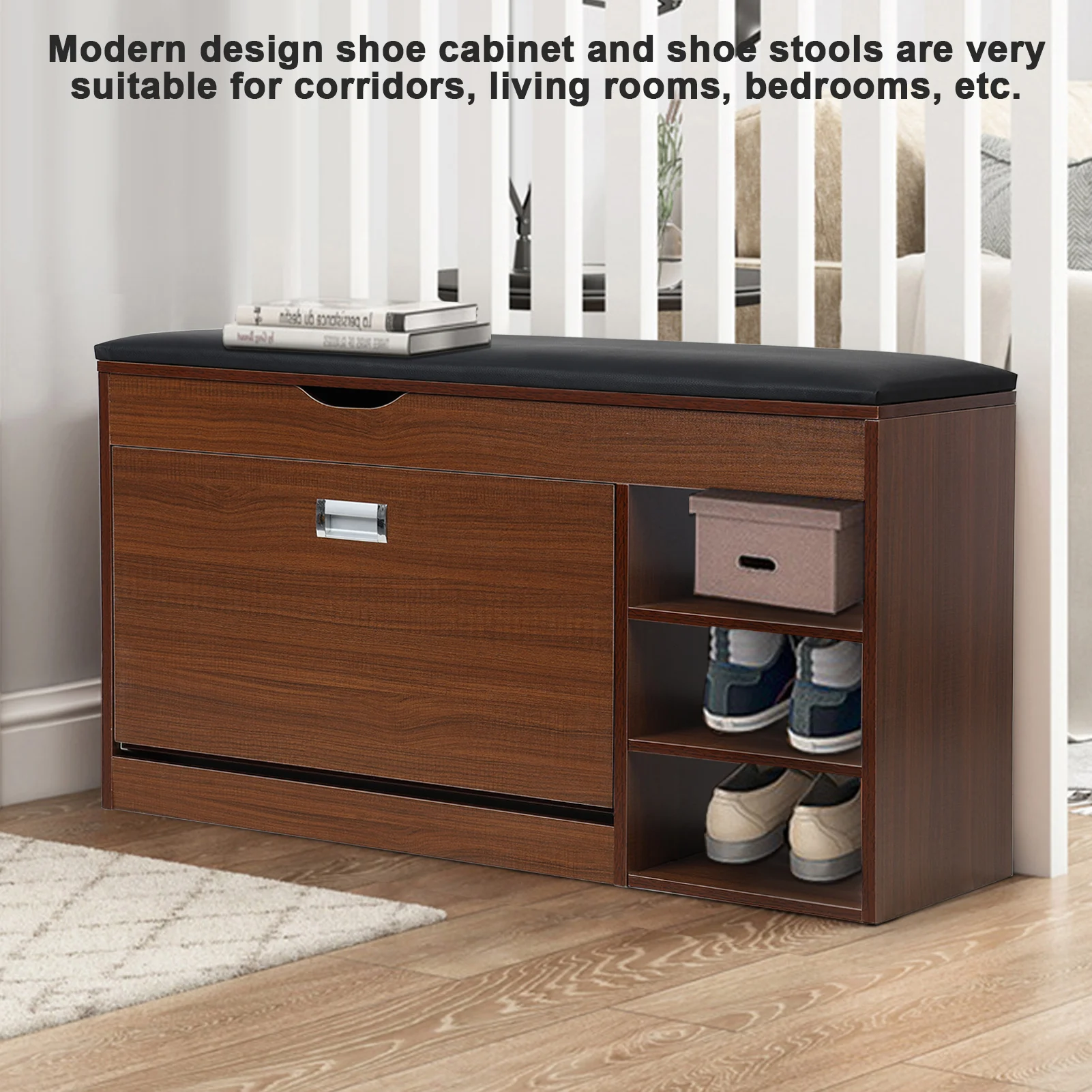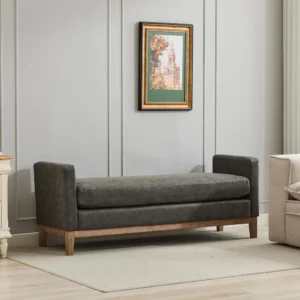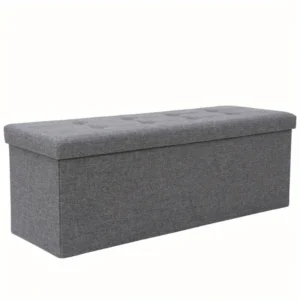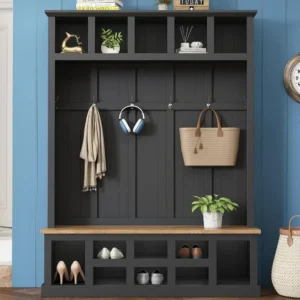Introduction: Making Every Square Foot Count in Your Apartment
Living in an apartment often means making tough choices about furniture and storage. With limited square footage, every piece needs to earn its place in your home. This is where compact storage benches shine as true small-space heroes.
These multifunctional gems combine comfortable seating with hidden storage, effectively doing the work of two furniture pieces while taking up the footprint of just one. In an era where urban apartments are getting smaller and rent is climbing higher, smart furnishing choices have never been more important.
Storage benches offer a beautiful solution to the constant battle against clutter. They provide a place to sit while removing shoes, store seasonal items out of sight, and even serve as extra seating when guests arrive—all without demanding precious floor space that you simply don’t have.
Throughout this guide, we’ll explore the many types of storage benches available, help you select the perfect size and style for your needs, share strategic placement ideas, and provide practical tips for maximizing organization in your small living space. Understanding organizing small apartments benches can completely transform how you use your limited space.
Why Every Apartment Needs a Compact Storage Bench: Functions Beyond Seating
Storage benches are the Swiss Army knives of apartment furniture—they solve multiple problems while maintaining a small footprint. Their versatility makes them invaluable in tight spaces where every piece must serve multiple purposes.
Hidden Storage Solutions
The most obvious benefit is concealed storage space that eliminates visual clutter. Unlike open shelving that puts everything on display, storage benches keep items tucked away yet easily accessible. This is particularly valuable in studio apartments where your entire living space is visible at once. The benefits of using benches in studio apartments extend beyond just storage to actually defining different functional zones within an open layout.
Extra Seating Without Bulk
When friends visit your apartment, seating often becomes scarce. A storage bench provides ready seating without requiring the floor space of additional chairs that would otherwise sit unused most days. Many entryway bench storage options are designed to comfortably seat two adults while maintaining a slim profile against a wall.
Surface Functionality
The top of a storage bench serves as valuable surface space for everyday items like keys and mail in an entryway, or decorative elements that personalize your space. This eliminates the need for additional tables or consoles that would consume more floor area.
Psychological Benefits
Never underestimate the mental benefits of reduced visual clutter. Storage benches help create a more peaceful environment by keeping necessities close at hand but out of sight. This sense of order has been shown to reduce stress and improve focus—particularly important in small spaces where clutter is more visually dominant.
Cost-Effective Solution
Purchasing separate storage units and seating would not only consume more space but also cost significantly more. A single well-designed storage bench typically costs less than buying both items separately, while saving approximately 4-6 square feet of floor space—significant in an apartment where every inch counts.
Strategic Placement: Where to Position Your Storage Bench
The beauty of compact storage benches lies in their versatility. Knowing exactly where to place these multifunctional pieces can maximize both their practicality and your apartment’s functionality.
Entryway Essentials
The apartment entryway is perhaps the most natural home for a storage bench. This high-traffic area benefits from a piece that creates an organized landing zone for everyday items while providing a place to sit when removing shoes. Transform tiny apartment entryway hacks often center around properly sized benches that create an organized transition from outside to inside.
For particularly narrow entryways, narrow entryway bench options with depths of just 12-14 inches can transform even the slimmest spaces without impeding movement. Position these against the wall opposite your door to create an intentional entry zone without blocking traffic flow.
Living Room Applications
In living rooms, storage benches work wonderfully in several strategic locations:
- Under windows: Replace traditional window seating while gaining storage for throw blankets and media items
- As coffee table alternatives: Choose a bench with a flat, sturdy top that can hold drinks and books while hiding gaming equipment or extra pillows below
- Against walls: Create additional seating that doesn’t protrude far into the room’s center, maintaining open flow
For optimal living room placement, ensure at least 24-30 inches of clearance in front of the bench to allow comfortable seating without creating tight passages.
Bedroom Positioning
In bedrooms, consider these placement options:
- End of bed: A bench across the foot of your bed creates a finished look while storing extra bedding or out-of-season clothing
- Under windows: Utilize otherwise awkward spaces while creating a cozy reading nook
- As nightstand alternatives: Narrow benches can replace traditional nightstands while adding seating and storage
Dining Area Integration
In apartment dining areas, consider using storage benches as built-in seating along one side of the table. This arrangement saves space compared to chairs that need clearance to pull out, while providing hidden storage for table linens, serving pieces, or rarely used kitchenware.
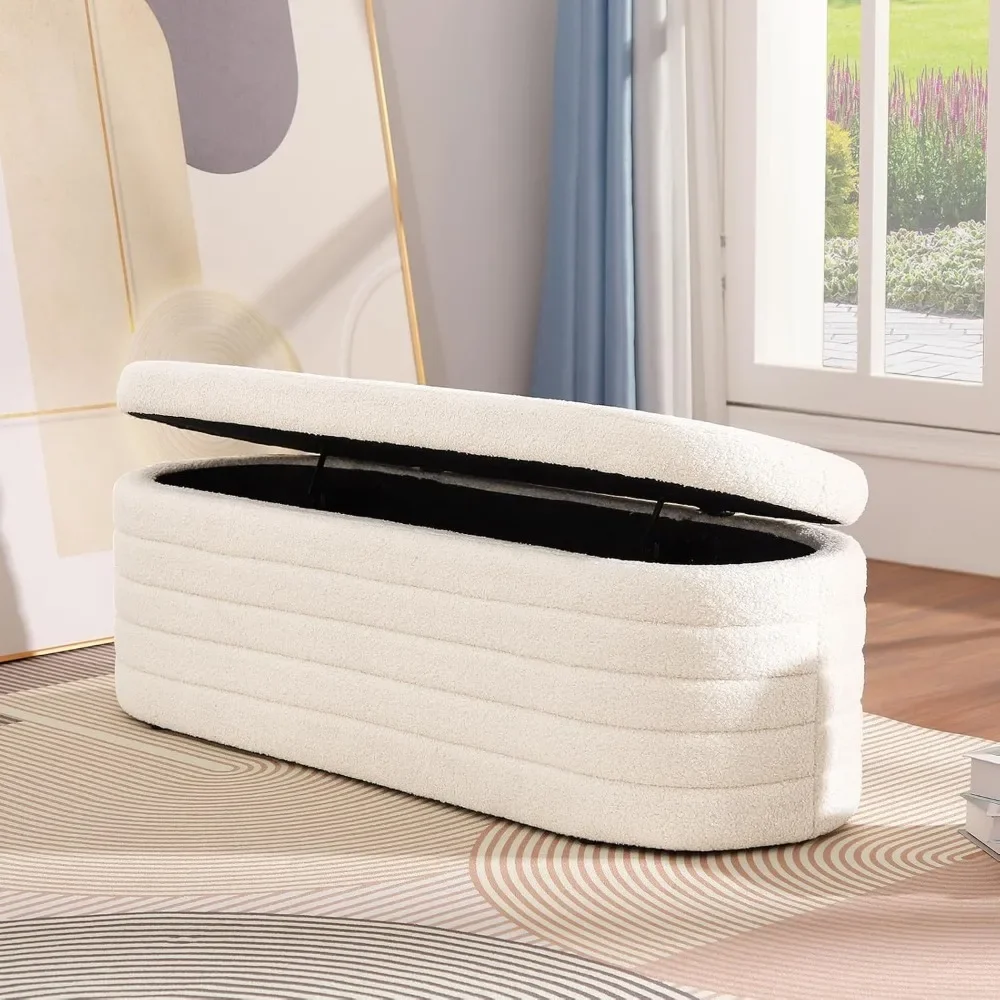
Types of Compact Storage Benches: Finding Your Perfect Match
Different storage needs and space constraints call for specific bench designs. Understanding the variety of options will help you select the perfect match for your apartment.
Flip-Top Storage Benches
These traditional trunk-style benches feature a hinged lid that opens to reveal a single large compartment. They offer several advantages:
- Maximum storage volume: The entire bench interior serves as storage space
- Clean, seamless appearance: No visible storage compartments maintain a streamlined look
- Versatile storage capacity: Accommodates bulky items like blankets and pillows
- Typical dimensions: 36-48 inches wide, 16-18 inches deep, 18-20 inches tall
These benches work particularly well in bedrooms and living rooms where larger items need storage. Many top small benches hidden storage designs use this mechanism for its simplicity and effectiveness.
Cubby/Shelf Benches
These feature open storage compartments beneath the seating surface:
- Visible, accessible storage: Perfect for frequently accessed items
- Organizational structure: Built-in divisions keep items separated and organized
- Decorative potential: Allows for display of attractive items while hiding others
- Typical dimensions: 36-42 inches wide, 14-16 inches deep, 18-20 inches tall
Cubby benches from small entryway bench collections work exceptionally well for shoe storage in entry areas, allowing footwear to air out rather than being enclosed.
Drawer Benches
These incorporate pull-out drawers beneath the seating surface:
- Organized accessibility: Contents remain organized even when accessing specific items
- Better for small items: Prevents small objects from getting lost in larger compartments
- Ease of access: No need to remove items from the bench top to access storage
- Typical dimensions: 36-48 inches wide, 16-18 inches deep, 20-22 inches tall
Entryway bench drawers offer excellent organization for smaller items like gloves, scarves, and tech accessories without requiring you to lift a heavy lid.
Ottoman Benches
These feature removable or flip-up tops on a smaller footprint:
- Extreme versatility: Can function as seating, tables, or footrests
- Mobility: Often lightweight enough to move as needed
- Smaller footprint: Typically the most compact storage bench option
- Typical dimensions: 15-30 inches wide, 15-20 inches deep, 16-18 inches tall
Narrow Hall Benches
Specifically designed for tight spaces:
- Slim profile: Typically only 10-14 inches deep
- Space-saving design: Often include specialized storage features like vertical dividers
- Entry-focused: Commonly include shoe storage features
- Typical dimensions: 24-36 inches wide, 10-14 inches deep, 18-20 inches tall
Modular/Sectional Storage Benches
These flexible options can be reconfigured or combined:
- Customizable arrangements: Can be separated or joined based on needs
- Scalable solution: Add pieces as space allows or needs change
- Multiple storage mechanisms: Often combine different storage types (drawers, cubbies, etc.)
- Typical dimensions: Variable, with individual sections typically 15-24 inches wide
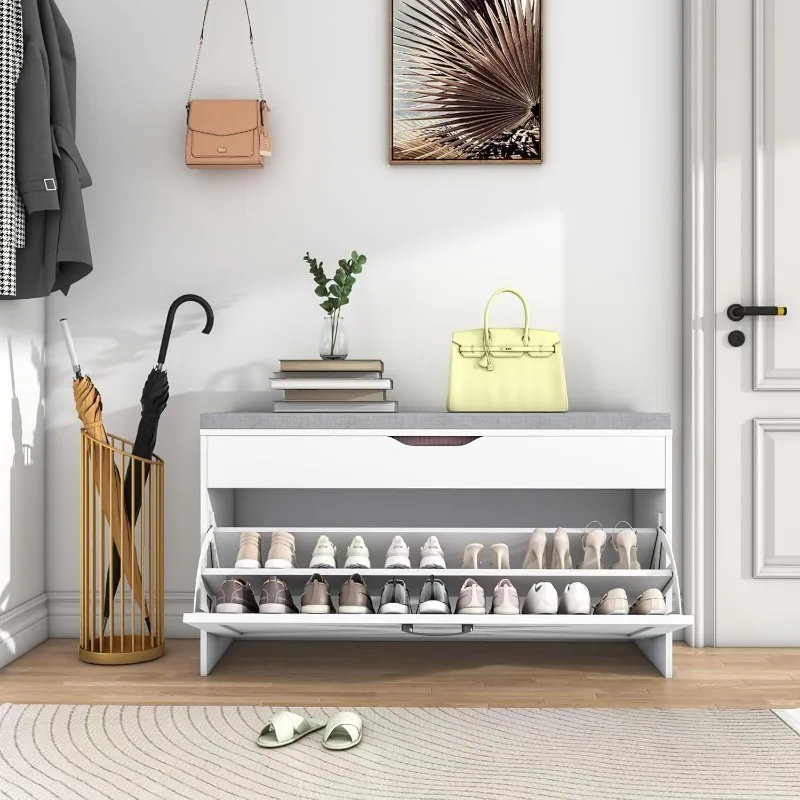
Material Matters: Choosing Durable, Apartment-Friendly Options
The materials used in your storage bench affect not just its appearance, but also its durability, weight, and maintenance requirements—all critical considerations for apartment living.
Engineered Wood/Particleboard
Pros:
– Budget-friendly pricing
– Lightweight for easier moving
– Available in numerous finishes and colors
– Generally sufficient strength for average use
Cons:
– Less durable than solid wood
– Can be damaged by moisture
– May deteriorate after several years of heavy use
– Visible wear occurs more quickly
These materials typically make up the majority of affordable wood entryway bench options, with prices usually ranging from $80-$150.
Solid Wood
Pros:
– Exceptional durability and longevity
– Premium, classic appearance that ages well
– Better weight capacity for seating multiple people
– Sustainable option if responsibly sourced
Cons:
– Significantly heavier to move (challenging in walk-up apartments)
– Higher price point
– May require occasional maintenance
– Can be susceptible to scratches and moisture damage
Solid wood benches typically range from $150-$400 but can last for decades with proper care. Modern bench styles small spaces often incorporate wood with metal elements for a contemporary look that maintains durability.
Metal Frames with Fabric
Pros:
– Lightweight yet sturdy construction
– Modern aesthetic
– Excellent strength-to-weight ratio
– Resistance to most forms of damage
Cons:
– Fabric portions require more frequent cleaning
– Limited storage capacity in many designs
– Can feel cold or industrial in some spaces
– Potential for fabric wear over time
These typically range from $100-$250 depending on fabric quality and frame construction.
Upholstered Options
Pros:
– Superior comfort for extended seating
– Extensive style and color options
– Softens room aesthetics
– Can coordinate with existing furniture
Cons:
– Requires more frequent cleaning
– More vulnerable to stains and damage
– Usually less storage capacity
– Often less sturdy construction
Upholstered storage benches typically range from $120-$300 depending on fabric quality.
Plastic/Composite Materials
Pros:
– Extremely lightweight
– Completely waterproof options available
– Easy to clean with simple wiping
– Often the most affordable option
Cons:
– Less premium appearance
– Typically lower weight capacity
– Shorter lifespan than other materials
– Limited style options
These budget-friendly options usually range from $50-$120.
Smart Features to Look For: Maximizing Functionality
Certain features can dramatically enhance the utility of your storage bench in a small apartment. Here are the functionalities worth prioritizing:
Safety and Convenience Features
Soft-Close Hinges
These prevent the bench lid from slamming down on fingers and reduce noise—a valuable feature in close-quarters apartment living. Worth the additional $20-30 cost for both safety and noise reduction, especially in studio apartments where every sound carries.
Divided Interior Compartments
Built-in dividers prevent items from becoming a jumbled mess and make retrieval easier. This feature is particularly valuable for benches storing diverse items like accessories, electronics, and paperwork.
Removable Storage Bins/Baskets
These allow you to pull out entire sections of storage rather than rummaging through the bench. Especially useful for seasonal item rotation or accessing items at the back of deep storage areas.
Enhanced Functionality
Built-in Charging Ports
Some modern benches include USB ports or power outlets, perfect for entryway charging stations. This eliminates the need for separate charging areas in space-constrained apartments.
Water-Resistant Materials
Essential for entryway benches that may encounter wet shoes and umbrellas. Look for sealed wood finishes or synthetic materials that won’t warp or stain when exposed to moisture.
Adjustable/Removable Cushions
Entryway bench cushion options with removable covers allow for cleaning and style updates without replacing the entire piece. Washable covers are particularly valuable in high-traffic areas.
Advanced Storage Solutions
Lockable Storage
Some benches offer lockable compartments for securing valuables—useful in shared living situations or for keeping certain items away from children or pets.
Convertible Designs
Benches that transform from seating to tables or other functions provide exceptional versatility in small spaces. Some even expand in width or convert from individual seating to bench configurations.
When evaluating these features, consider your daily routines and storage priorities. For example, if you frequently access items while others are seated on the bench, drawer models eliminate the need to ask someone to stand up compared to flip-top designs.
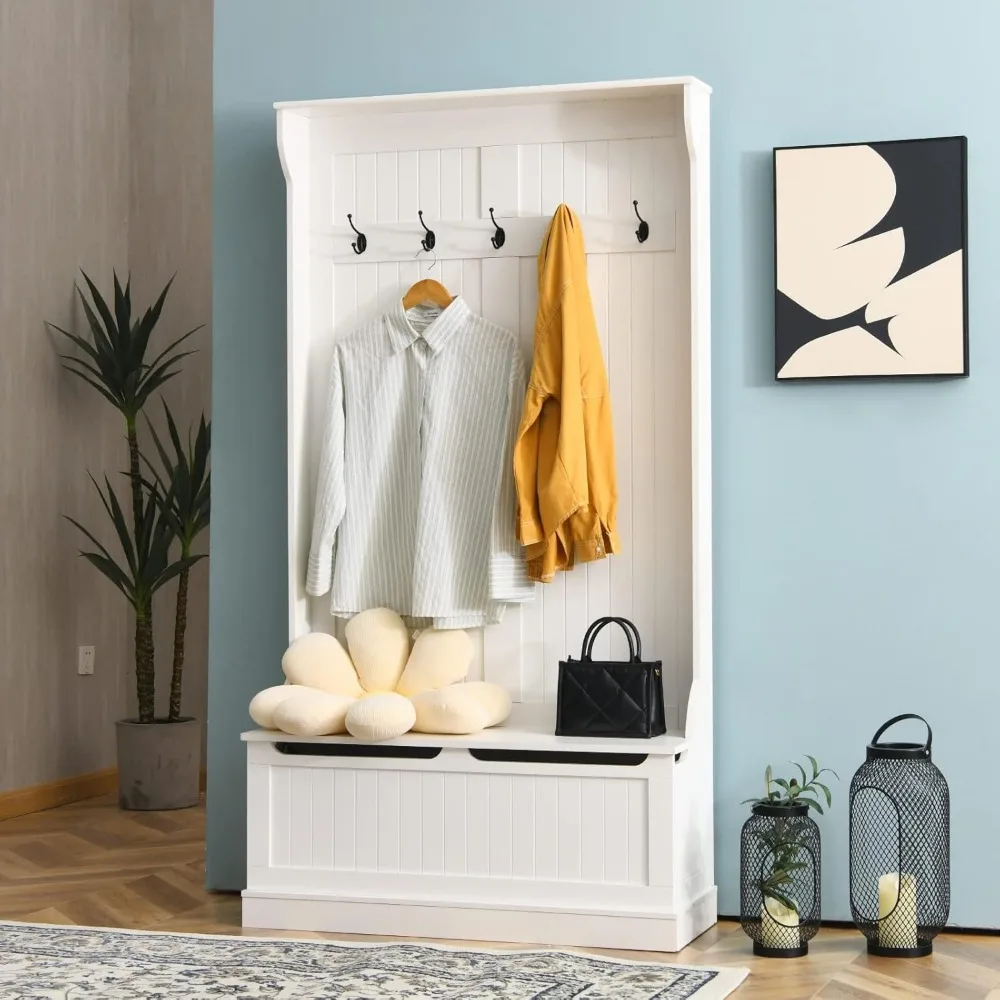
The Perfect Fit: Sizing Your Storage Bench for Small Spaces
Finding the right dimensions for your storage bench is crucial in small apartments where every inch matters. Here’s how to ensure you select a perfectly sized option for your space.
Measurement Fundamentals
Before shopping, measure your available space carefully, accounting for:
- Wall length where the bench will sit
- Maximum depth that won’t impede traffic flow
- Height that coordinates with adjacent furniture
- Door swings that might contact the bench
- Clearance needed for comfortable seating (about 24 inches in front)
Pro tip: Use painter’s tape on your floor to outline the bench’s footprint. Live with this taped outline for a day to ensure it doesn’t disrupt your movement patterns.
Location-Specific Sizing Guidelines
Entryway Benches
– Width: Typically 30-48 inches works well for average apartment entries
– Depth: Critical dimension—keep to 12-15 inches in narrow hallways
– Height: 18-20 inches provides comfortable seating while putting on shoes
Optimizing small entryway perfect benches often means prioritizing depth over width to maintain clear pathways. For extremely tight spaces, corner entryway bench options utilize otherwise wasted corner space effectively.
Living Room Benches
– Width: 36-48 inches accommodates two adults comfortably
– Depth: 16-18 inches balances seating comfort with space efficiency
– Height: Should align with sofa seat height (typically 17-19 inches)
Bedroom Benches
– Width: For end-of-bed placement, choose a bench about 12-18 inches narrower than your bed width
– Depth: 16-18 inches provides adequate seating without protruding too far
– Height: Typically 18-20 inches, but consider bed height for proportion
Storage Volume Considerations
Remember that external dimensions don’t tell the whole story. Consider these interior storage factors:
- Flip-top benches typically offer 80-90% of their external volume as storage
- Drawer benches usually provide 50-70% of their volume as usable storage
- Wall clearance needed for lids to open fully (typically 2-4 inches)
- Interior height needed for specific items (shoe storage requires at least 6-8 inches)
For maximum efficiency in extremely small apartments, look for benches with height-to-storage ratios that favor storage space over tall legs or thick frames.
Buyer’s Guide: Evaluating Quality and Value
Investing in the right storage bench means understanding how to assess quality and determine what represents good value for your specific needs.
Construction Quality Indicators
Joinery Methods
– Dovetail or mortise-and-tenon joints indicate superior craftsmanship in wooden benches
– Corner blocks and reinforced stress points suggest durability
– Visible screws often indicate lower-quality construction compared to hidden fasteners
– Well-aligned parts with tight seams typically reflect better manufacturing standards
Weight Capacity Ratings
– Look for clearly stated weight limits (quality benches typically support 250-400 pounds)
– Benches for multiple people should support at least 300 pounds
– Internal storage weight limits are equally important—typically 30-50 pounds for shelves
Warranty Coverage
– 1-year warranties are standard for budget options
– 3-5 year warranties indicate manufacturer confidence in durability
– Warranties covering structural elements rather than just defects suggest better quality
Stability Features
– Wide, solid base prevents tipping
– Non-slip feet protect flooring and prevent shifting
– Reinforced corners reduce wobbling over time
Price Tier Analysis
Budget Options ($50-$100)
– Typically feature engineered wood or plastic construction
– Basic storage mechanisms with fewer divisions
– Simpler designs with limited features
– Expected lifespan of 2-4 years with regular use
Mid-Range Options ($100-$200)
– Better materials like solid wood components or higher-grade engineered wood
– Enhanced features such as soft-close hinges or removable bins
– More storage configurations and aesthetic options
– Expected lifespan of 5-8 years with proper care
Premium Options ($200+)
– Solid wood construction or high-end materials throughout
– Superior mechanisms and hardware
– Customizable features and unique designs
– Expected lifespan of 10+ years with normal use
Best storage benches small apartments often fall in the mid-range category, offering the best balance between quality construction and affordability for most apartment dwellers.
Practical Shopping Advice
When evaluating assembly requirements:
– “No assembly required” often means higher shipping costs
– “Partial assembly” typically involves attaching legs or simple hardware
– “Full assembly required” may take 30-90 minutes depending on complexity
Return policy considerations:
– Check measurement allowances (some policies don’t cover “it doesn’t fit”)
– Understand who covers return shipping (often the buyer for furniture)
– Note packaging requirements for returns (original packaging may be required)
Making trade-offs:
When budget constraints exist, prioritize:
– Structural integrity over aesthetic details
– Storage capacity over decorative elements
– Quality hardware over fancy finishes
Top Recommendations: Space-Saving Storage Benches for Every Need
Finding the perfect storage bench for your specific apartment needs means focusing on specialized features for different use cases. Here’s a breakdown of the best options for various apartment scenarios:
Best for Tiny Entryways
Ultra-narrow storage benches designed specifically for tight corridors offer maximum function in minimal space:
- Typical width: 24-36 inches
- Depth: Just 10-12 inches (compared to standard 15-18 inches)
- Height: 18-20 inches for comfortable seating
- Storage mechanism: Usually open cubbies or small drawers
- Price range: $80-$150
These slim-profile options from modern entryway bench collections prioritize depth reduction without sacrificing functionality. Look for models with vertical dividers for storing shoes upright to maximize capacity in minimal footprint.
Best for Maximum Storage Volume
When storage capacity is your primary concern:
- Typical width: 40-48 inches
- Depth: 16-18 inches
- Height: 18-22 inches with minimal leg height
- Storage mechanism: Deep flip-top design with minimal frame thickness
- Price range: $120-$250
These maximized-volume designs offer up to 30% more storage space than standard benches of similar external dimensions. The key feature is minimized material thickness and structural elements that don’t intrude into the storage cavity.
Best for Frequent Seating
For benches that will serve as regular seating rather than occasional use:
- Typical width: 36-48 inches
- Depth: 15-18 inches
- Height: 17-19 inches (optimal seating height)
- Cushion thickness: 2-4 inches of high-density foam
- Price range: $150-$300
Look for models with ergonomic back angles if they’ll be placed against a wall, or apartment friendly storage bench ideas that incorporate proper lumbar support for longer sitting sessions.
Best for Style-Conscious Apartments
Design-forward options that make a visual statement:
- Contemporary designs with mixed materials (wood with metal accents)
- Custom upholstery options in premium fabrics
- Architectural elements like tapered legs or floating appearances
- Innovative opening mechanisms that enhance visual appeal
- Price range: $180-$400
These designer-inspired pieces often incorporate unexpected elements like contrasting materials, unique hardware, or specialized finishes that complement modern apartment aesthetics.
Best Budget-Friendly Options
Quality storage solutions that won’t break the bank:
- Typical width: 30-36 inches
- Materials: Engineered wood with laminate finishes
- Storage mechanism: Simple flip-top or open cubby design
- Assembly: Usually required but straightforward
- Price range: $60-$100
These practical options prioritize function over premium materials while maintaining adequate durability for typical apartment use.
Entryway Bench with Cushion, Mudroom Bench with Cushion, Shoe Bench for Entryway
$1,186.63 Select options This product has multiple variants. The options may be chosen on the product pageCoat Rack Shoe Bench, Corner Entryway Bench, Corner Hall Tree, Shoe Bench for Entryway
$313.58 Select options This product has multiple variants. The options may be chosen on the product pageEntryway Bench with Back, Modern Entryway Bench, Shoe Bench for Entryway
Price range: $463.13 through $474.44 Select options This product has multiple variants. The options may be chosen on the product pageEntryway Bench with Shelf Storage, Shoe Bench for Entryway, Shoe Storage Bench
$194.08 Select options This product has multiple variants. The options may be chosen on the product pageCorner Entryway Bench, Entryway Bench with Cushion, Modern Entryway Bench, Shoe Bench for Entryway
$476.34 Select options This product has multiple variants. The options may be chosen on the product pageBench with Hooks and Storage, Entryway Hall Tree, Mudroom Bench with Cubbies, Mudroom Bench with Shoe Storage
$818.38 Select options This product has multiple variants. The options may be chosen on the product page
While evaluating these specialized options, remember that versatility champions—benches that can work in multiple settings or be easily moved between rooms—offer the most long-term value for apartment dwellers who may relocate frequently.
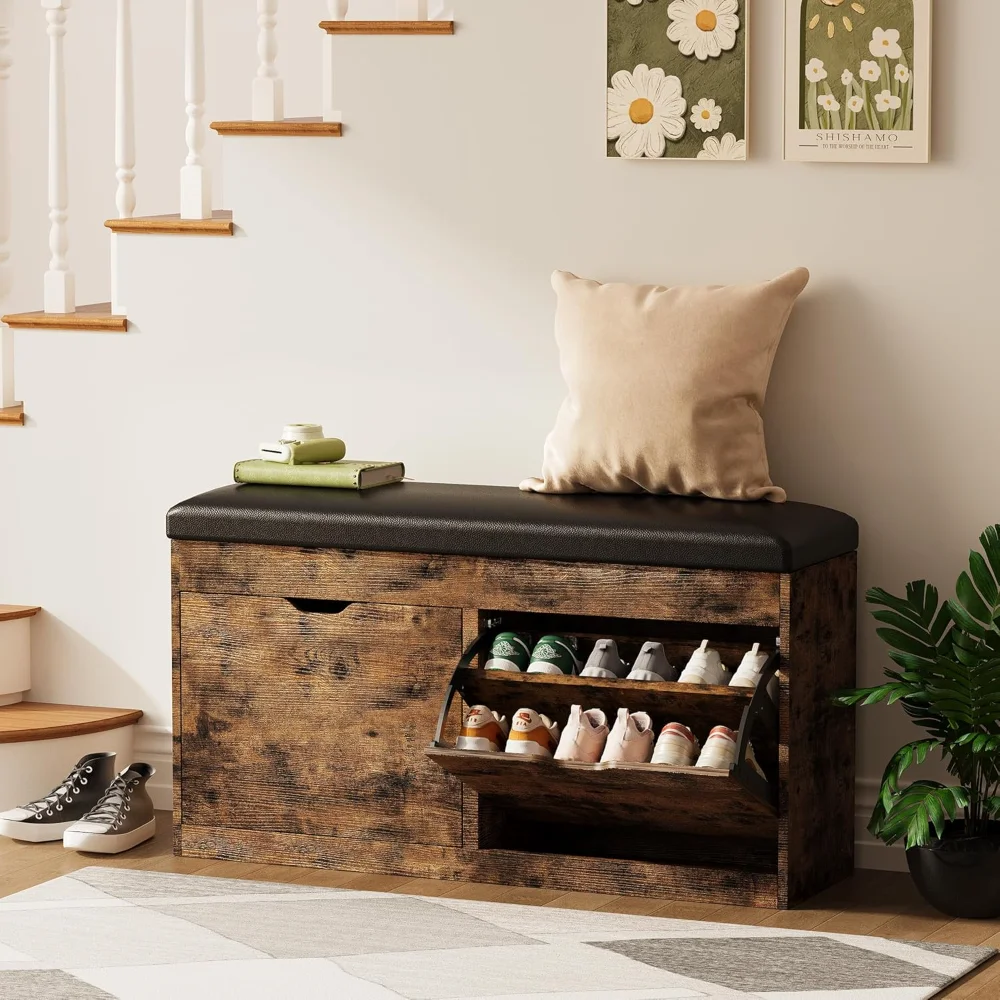
Styling Your Storage Bench: Design Tips for Small Spaces
A storage bench should do more than just provide function—it should enhance your apartment’s aesthetic appeal. Here’s how to style your bench for maximum visual impact in limited space.
Color Selection Strategies
In small spaces, color choices significantly impact perceived spaciousness:
- Light neutrals (white, cream, light gray) visually expand space and provide versatility
- Bold accent colors can make your bench a focal point, but limit these to smaller benches
- Tone-on-tone approaches (bench color similar to wall color) create visual cohesion and the illusion of more space
- Contrasting colors define zones but can make spaces feel chopped up—use strategically
For maximum versatility, consider neutral bench frames with cushions or accessories that can be changed seasonally or as design preferences evolve.
Accessorizing Without Sacrificing Function
The key to successful bench styling is enhancing appearance without compromising utility:
- Selective cushioning: Use slim cushions that don’t reduce storage access
- Textural elements: Add small throw pillows at one end rather than across the entire bench
- Practical decorative items: Place a small tray for keys that serves both function and style
- Minimal display: In entryways, limit decorative items to 1-2 pieces that won’t need constant moving
Design Approaches for Different Apartment Styles
Minimalist Approach
– Clean, straight lines with hidden storage mechanisms
– Monochromatic or subtle two-tone color schemes
– Absence of visible hardware or decorative elements
– Focus on form and proportion rather than embellishment
Bohemian Style
– Natural materials like rattan, wicker, or reclaimed wood
– Colorful cushions with global-inspired patterns
– Mixed textures combining smooth and rough surfaces
– Open storage that displays carefully curated items
Modern Aesthetic
– Mixed materials like metal frames with wood tops
– Geometric design elements and asymmetrical features
– Technology integration (charging stations, smart storage)
– Bold color blocking or high-contrast elements
Traditional Style
– Classic forms with decorative legs or moldings
– Rich wood tones and substantial construction
– Symmetrical design with centered cushions or accessories
– Complementary traditional hardware like brass or bronze
Maximizing compact benches renters often involves versatile styling approaches that can adapt to changing apartments or evolving personal taste. Removable elements like cushions, baskets, and decorative trays allow for easy updates without replacing the bench itself.
Remember that in small spaces, visual breathing room is crucial—resist the urge to overcrowd your bench with decorative items that compromise its function or create visual clutter.
Organization Mastery: Maximizing Your Bench’s Storage Potential
The true value of a storage bench lies in how effectively you organize its interior space. Strategic organization can increase usable storage by up to 30% compared to simply placing items inside.
Containerization Strategies
Containerization transforms amorphous storage space into efficient, accessible organization:
- Fabric bins divide large compartments into manageable sections
- Clear containers make contents visible without opening
- Stackable boxes maximize vertical space in deep storage areas
- Drawstring bags contain small items that would otherwise scatter
For flip-top benches, consider using containers with handles that make retrieval from deep spaces much easier.
Category-Based Organization Systems
Grouping similar items together maximizes efficiency and prevents the “where did I put that?” syndrome:
- Seasonal grouping: Summer accessories in one container, winter items in another
- User-specific sections: Designate areas for each household member
- Frequency-of-use sorting: Most-used items in front/top, occasional items in back/bottom
- Activity-based organization: Group items needed for specific activities together
Content-Specific Organization Solutions
Shoe Organization in Storage Benches
Shoe storage bench options often include specialized features, but you can enhance any bench for footwear storage:
– Shoe stacker inserts double capacity for flats and sandals
– Boot shapers prevent tall boots from collapsing
– Shoe bags protect special occasion footwear
– Vertical dividers create individual slots for each pair
Textile Storage
For blankets, throws, and seasonal linens:
– Vacuum storage bags can reduce volume by up to 75%
– Fabric shelf dividers prevent stacks from toppling
– Compression straps keep folded items compact
– Lavender sachets keep contents fresh during storage
Entryway Organization
Crafting welcoming functional entry spaces means organizing small items effectively:
– Small containers for keys, sunglasses, and phone accessories
– Hook systems attached to bench backs for bags and jackets
– Divided trays for mail and important papers
– Designated spots for frequently used items
Maintenance of Organization Systems
Even the best organization system requires maintenance:
- Schedule quarterly “purge and reassess” sessions
- Rotate seasonal items to the front when their season approaches
- Wipe down interior surfaces and containers to prevent dust buildup
- Refresh any scent sachets or moisture absorbers
With thoughtful organization, a single storage bench can effectively manage the contents that might otherwise require several separate storage pieces—a critical space-saving advantage in apartment living.
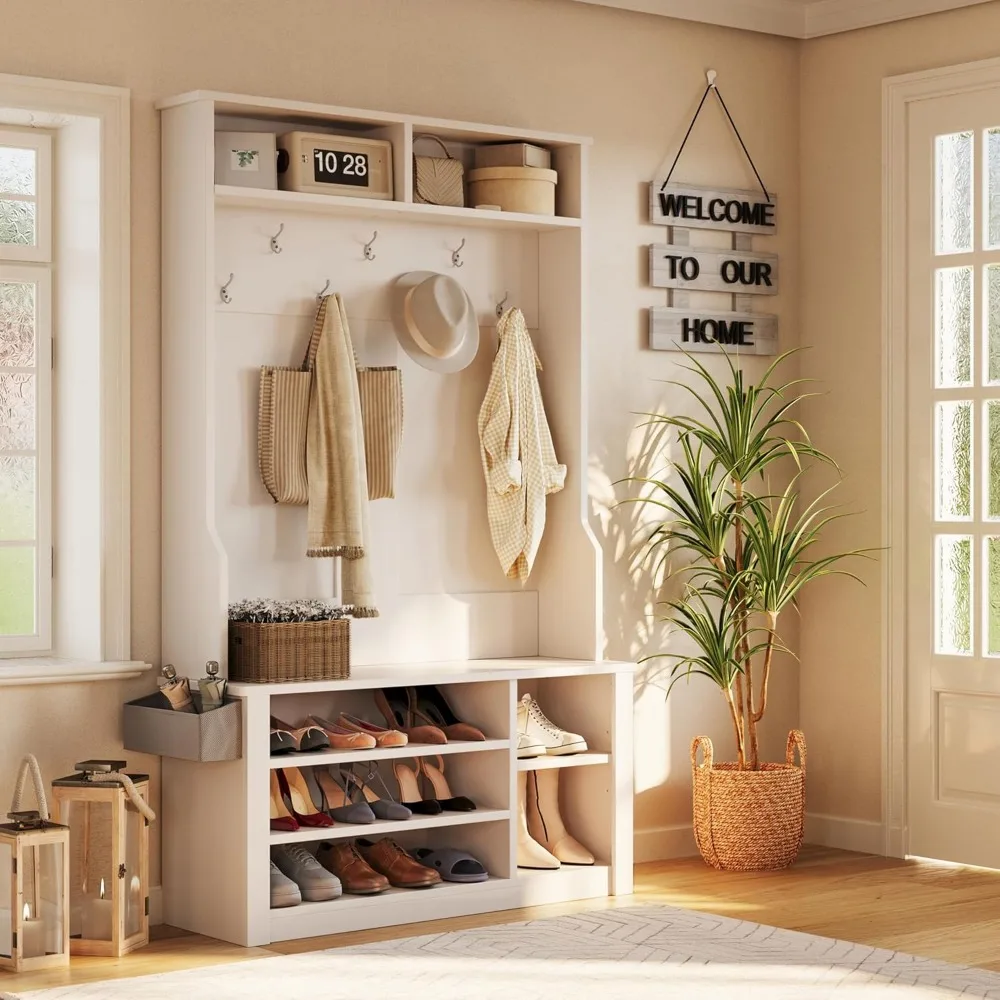
Care and Maintenance: Protecting Your Investment
Proper maintenance ensures your storage bench remains functional and attractive for years. Different materials require specific care approaches to maximize longevity.
Wood Care Essentials
For both solid wood and wood composite benches:
– Dust regularly with a soft, slightly damp cloth
– Clean spills immediately to prevent staining
– Apply furniture polish appropriate for your finish type quarterly
– Avoid placing in direct sunlight which can cause fading and drying
– Maintain consistent humidity levels to prevent warping (especially important in apartments with forced-air heating)
For scratches in wood finishes:
– Minor scratches: Touch up with matching furniture markers
– Deeper gouges: Fill with wood putty, then stain to match
– White water marks: Often removable with non-gel toothpaste or a mixture of baking soda and olive oil
Upholstery Maintenance
For fabric bench tops and cushions:
– Vacuum regularly using upholstery attachments
– Treat stains immediately following fabric-specific recommendations
– Apply fabric protector spray to prevent future staining
– For removable covers, launder according to care instructions
– Rotate cushions regularly to ensure even wear
For spot cleaning:
– Most fabrics: Mix mild dish soap with water, apply with cloth, and blot dry
– Microfiber: Use rubbing alcohol on a white cloth for spot treatment
– Leather/faux leather: Wipe with a leather cleaner and condition quarterly
Hardware Maintenance
Proper hardware care prevents operational issues:
– Tighten all visible screws quarterly (particularly on frequently opened lids)
– Lubricate hinges with silicone spray when they begin to squeak
– Check lid supports and adjust or replace if they begin to weaken
– Clean drawer slides with a dry cloth and apply silicone lubricant if sticking occurs
Preventive Measures
- Use felt pads under all legs to protect flooring and prevent scratches
- Apply furniture wax to wooden drawer slides for smoother operation
- Place benches away from heating vents which can dry out wood
- Use coasters under any drinks placed on wooden bench tops
- Consider bench pads or runners to protect tops from damage
Troubleshooting Common Issues
- Wobbly bench: Tighten all fasteners and check for structural damage
- Sticking drawers: Clean tracks and apply appropriate lubricant
- Sagging cushions: Fluff regularly and consider adding polyester fiberfill to restore shape
- Musty interior odors: Place activated charcoal, baking soda, or cedar blocks inside
With proper care, a quality storage bench can remain functional and attractive for many years, making it a worthwhile investment for apartment living.
DIY Solutions: Customizing Storage Benches for Your Needs
Even ready-made storage benches can be personalized to better suit your specific apartment needs. These customization options range from simple no-tool modifications to more involved projects.
Style Updates for Purchased Benches
Cushion Refreshes
– Recover existing cushions with new fabric (approximately $20-30 for fabric and supplies)
– Replace flat cushions with thicker, more comfortable versions
– Add ties or velcro to secure cushions to the bench frame
– Layer smaller decorative pillows for added comfort and style
Finish Modifications
– Refinish wood surfaces with paint or stain for color coordination
– Add decorative elements like stencils or patterns to flat surfaces
– Update hardware with new knobs, pulls, or hinges that match your décor
– Apply peel-and-stick wallpaper to drawer fronts or side panels for instant transformation
Functional Enhancements
Interior Organization Additions
– Install tension rods to create dividers within large storage compartments
– Add adhesive-backed hooks to lid interiors for hanging small items
– Insert adjustable drawer dividers for customized compartments
– Include cedar planks or lavender sachets for freshness
Structural Modifications
– Replace standard legs with casters for mobility (ensure they lock for safety)
– Add padding to lid undersides to create soft-close functionality
– Install additional support bracing for increased weight capacity
– Attach backing material to open cubby benches for a more finished look
Maximizing space style studio apartments often involves these types of creative adaptations that make standard furniture pieces work harder for your specific needs.
Skill-Level Appropriate Projects
No-Tool Modifications
– Insert pre-made drawer organizers or baskets
– Use adhesive-backed felt to line drawers or compartments
– Add non-slip shelf liner to bench tops for decorative item stability
– Employ furniture grippers under legs to prevent sliding
Basic Tool Projects (screwdriver, hammer, measuring tape)
– Install aftermarket soft-close hinges
– Add protective corner bumpers for safety
– Attach a small side table extension for expanded surface area
– Mount hooks or a small shelf above the bench for additional storage
Intermediate Projects (requires basic power tools)
– Convert a flip-top bench to divided storage by adding interior partitions
– Add a hinged back to create a mini-mudroom bench
– Install under-bench lighting with adhesive LED strips
– Create pull-out trays for smaller items within large compartments
These customizations allow you to address specific storage challenges in your apartment while potentially saving hundreds of dollars compared to custom-built furniture. Most modifications can be completed in an afternoon and reversed when needed—perfect for rental apartments where permanent changes aren’t possible.
Frequently Asked Questions
How much weight can storage benches typically support?
Most quality storage benches support between 250-400 pounds of seating weight. The internal storage compartments typically hold 25-40 pounds safely. Always check manufacturer specifications, as exceeding weight limits can damage hinges and supports.
Are storage benches comfortable enough for daily seating?
Benches with cushioned tops at least 2 inches thick can provide comfortable seating for 30-60 minutes. For daily extended use, look for ergonomic designs with back support or cushions at least 3-4 inches thick with high-density foam that won’t compress quickly.
Can storage benches work in humid environments like bathrooms?
For bathroom use, select benches made with moisture-resistant materials like teak, plastic composites, or metal frames with sealed wood. Ensure adequate ventilation in the storage compartments, and consider models with ventilation holes if storing damp items like towels.
How do I keep items from getting musty inside storage benches?
Prevent mustiness by avoiding storing damp items, using cedar blocks or silica gel packets to absorb moisture, and occasionally leaving the lid open for air circulation. For enclosed storage benches, charcoal odor absorbers or coffee grounds in a mesh bag can help maintain freshness.
What’s the average lifespan of a quality storage bench?
With proper care, mid-range storage benches typically last 5-8 years with regular use. Premium benches constructed of solid wood or high-quality materials often last 10-15 years or more. Budget options generally provide 2-4 years of service before showing significant wear.
Beyond Storage Benches: Complementary Space-Saving Solutions
While storage benches offer remarkable versatility, pairing them with complementary space-saving furniture creates comprehensive organization systems for small apartments.
Wall-Mounted Storage Companions
Wall-mounted shelving or cabinets directly above a storage bench creates a complete entryway system without consuming additional floor space. This vertical approach can double your storage capacity while maintaining the same footprint. Bench hooks and storage combinations provide convenient places for coats and bags while keeping the floor clear.
Consider floating shelves above entryway benches for mail, keys, and decorative items, or cabinet systems that create a cohesive built-in appearance. The visual connection between bench and wall storage creates a deliberate, designed look rather than disconnected furniture pieces.
Nesting Tables for Flexible Surface Space
Nesting tables that tuck partially under storage benches provide expandable surface area when needed while minimizing footprint when not in use. Look for slim designs with heights that complement your bench, creating a coordinated furniture grouping that adapts to your changing needs.
Slim Console Tables for Expanded Organization
In entryways where space allows, pairing a storage bench with an ultra-slim console table (10-12 inches deep) creates separate zones for sitting and placing items. This combination works particularly well in entryways where the bench serves primarily for shoe storage and seating, while the console handles mail, keys, and decorative elements.
Under-Bed Storage Coordination
In bedrooms, storage benches at the foot of the bed can work in tandem with under-bed storage systems. Choose complementary designs and matching containers to create visual cohesion while maximizing every cubic inch of storage space.
When selecting complementary pieces, maintain consistent design elements—matching wood tones, coordinated metal finishes, or complementary fabric choices—to create a cohesive look that makes your apartment feel thoughtfully designed rather than pieced together.
Conclusion: Transform Your Apartment with Smart Storage Solutions
Compact storage benches represent one of the smartest investments you can make for small apartment living. These versatile pieces solve multiple challenges simultaneously—providing comfortable seating, concealing clutter, and maximizing the utility of your limited square footage.
The perfect storage bench does more than just store items; it transforms how you interact with your space. An entryway bench creates an organized landing zone that sets the tone for your entire apartment. A bedroom storage bench keeps extra linens at hand while providing a place to sit while dressing. A living room bench offers hidden storage for entertainment items while serving as extra seating when friends visit.
By selecting the right size, style, and storage mechanism for your specific needs, you’ll gain functionality that far exceeds the modest footprint these pieces require. The thoughtful organization systems we’ve explored further multiply this value, letting you store more items in less space while keeping them accessible and protected.
Whether you choose a sleek modern design from Nested Goods or a classic wooden piece with timeless appeal, your storage bench will quickly become one of the hardest-working furniture pieces in your apartment—proving that smart space solutions don’t have to sacrifice style or comfort.

